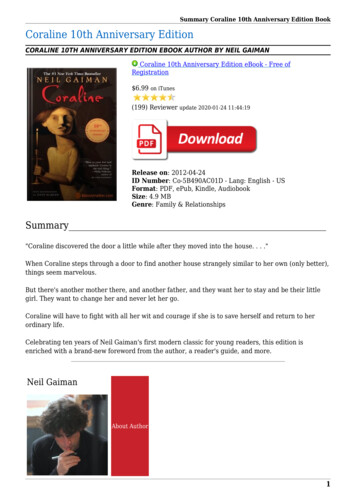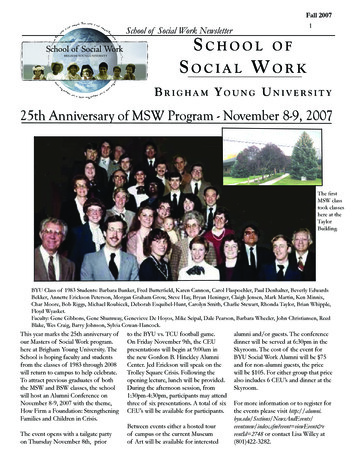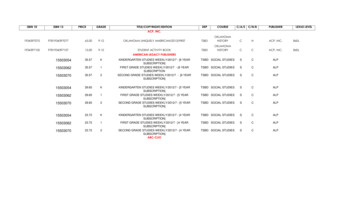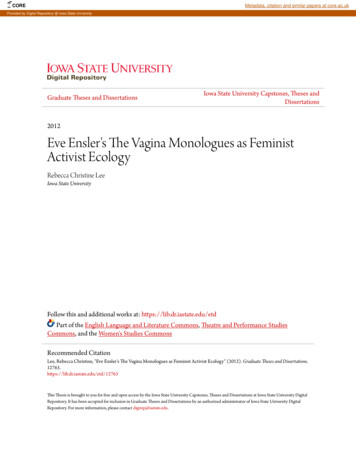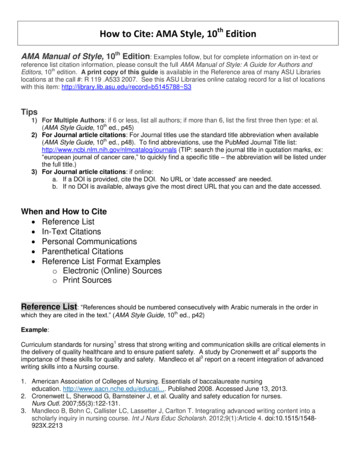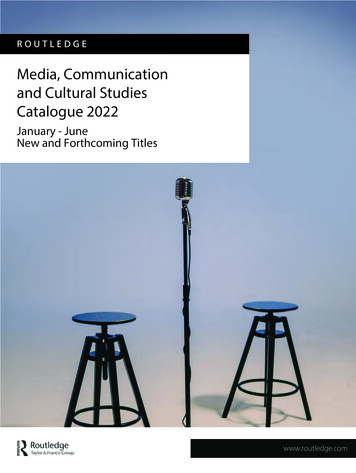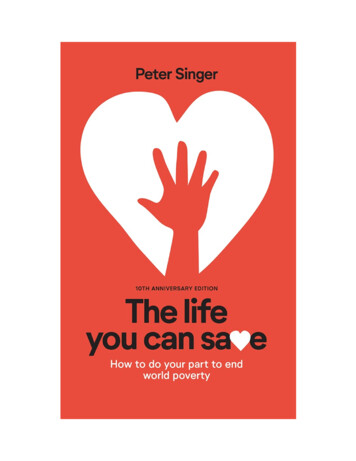
Transcription
Peter Singer was born in Melbourne, Australia, in 1946 andeducated at the University of Melbourne and the University ofOxford. He has taught at the University of Oxford, La TrobeUniversity, and Monash University, and has held several othervisiting appointments. Since 1999 he has been Ira W.DeCamp Professor of Bioethics at the University Center forHuman Values at Princeton University and since 2005, LaureateProfessor at the University of Melbourne, attached to the Schoolof Historical and Philosophical Studies.Singer first became well-known internationally after thepublication of Animal Liberation in 1975. His other books includePractical Ethics, Rethinking Life and Death, One World Now,and The Most Good You Can Do. Three collections of his writingshave been published: Writings on an Ethical Life and Ethics inthe Real World, which he edited, and Unsanctifying Human Life,edited by Helga Kuhse. He was the founding president of theInternational Association of Bioethics; and, with Paola Cavalieri,of The Great Ape Project. In 2005, Time magazine named him oneof the 100 most influential people in the world, and in 2009,The Sydney Morning Herald and The Age included him among
the most influential Australians of the past half century.Following the publication of the first edition of The Life YouCan Save, Singer founded the organization bearing the samename to help alleviate suffering and poverty in low-incomecountries. By recommending highly effective charities atwww.thelifeyoucansave.org, the organization aims to make it easyfor people to do “the most good” with their donations.Singer is married and has three daughters and fourgrandchildren. His recreations, apart from reading and writing,include hiking and surfing.The Life You Can Save relies on voluntary contributions to spreadPeter Singer’s ideas on donating to effective charities and thus toreduce global poverty.
Praise forThe Life You Can Save“A persuasive and inspiring work that will change the way youthink about philanthropy and that shows us we can make aprofound difference in the lives of the world’s poorest.”—BILL & MELINDA GATES“Mr. Singer is far from the world’s only serious thinker onpoverty, but with The Life You Can Save he becomes, instantly, itsmost readable and lapel-grabbing one.”—The New York Times“Faced with [Peter Singer’s] argument, it is hard not to askyourself how your own giving measures up. Yes, I will go onbuying things I do not really need. But, yes, this book haspersuaded me that I should give more—significantly more—tohelp those less fortunate.”—Financial Times“Powerful and clarifying Singer sets up a demanding ethicalcompass for human behavior.”—Sunday Star Ledger“This short and surprisingly compelling book sets out to answertwo difficult questions: why people in affluent countries shoulddonate money to fight global poverty and how much each shouldgive . Singer doesn’t ask readers to choose between asceticismand self-indulgence; his solution can be found in the middle, andit is reasonable and rewarding for all.”
— Publishers Weekly (starred review)“Be warned: reading this book may be dangerous to yourdefinitions of morality, charity, and how to be good. That is whyyou must read it.”—The Christian Science Monitor“If you think you can’t afford to give money to the needy, I urgeyou to read this book. If you think you’re already giving enough,and to the right places, still I urge you to read this book. In TheLife You Can Save, Peter Singer makes a strong case—logical andfactual, but also emotional—for why each of us should be doingmore for the world’s impoverished. This book will challenge youto be a better person.”—HOLDEN KARNOFSKY, co-founder, GiveWell“Peter Singer challenges each of us to ask: am I willing to makepoverty history? Skillfully weaving together parable, philosophy,and hard statistics, he tackles the most familiar moral, ethical,and ideological obstacles to building a global culture ofphilanthropy, and sets the bar for how we as citizens might do ourpart to empower the world’s poor.”—RAYMOND C. OFFENHEISER, president, Oxfam America
ALSO BY PETER SINGERDemocracy and DisobedienceAnimal LiberationPractical EthicsMarxAnimal Factories (with Jim Mason)The Expanding CircleHegelThe Reproduction Revolution (with Dean Wells)Should the Baby Live? (with Helga Kuhse)How Are We to Live?Rethinking Life and DeathEthics into ActionA Darwinian LeftWritings on an Ethical LifeUnsanctifying Human Life (edited by Helga Kuhse)One WorldPushing Time AwayThe President of Good and EvilHow Ethical Is Australia? (with Tom Gregg)The Ethics of What We Eat (with Jim Mason)The Point of View of the Universe (with Katarzyna de LazariRadek)The Most Good You Can DoFamine, Affluence and MoralityEthics in the Real WorldUtilitarianism: A Very Short Introduction (with Katarzyna de
Lazari-Radek)
Copyright 2009 by Peter SingerTenth Anniversary edition revisions 2019 by Peter SingerAll rights reserved.Tenth Anniversary edition edited by The Life You Can SaveCover design by W. H. ChongReleased throughout the world by The Life You Can Save, Bainbridge Island,Washington, USA & Sydney, Australia.Previously published and distributed in the United States by Random House, an imprintof The Random House Publishing Group, a division of Random House, Inc., 1745Broadway, New York, New York 10019; in Australia and New Zealand by TextPublishing, Melbourne; and in the United Kingdom by Picador, an imprint of PanMacMillan, London.First edition published March 2009; Paperback published September 2010Tenth Anniversary edition published November 2019ISBN though the author and publisher have made every effort to ensure that theinformation in this book was correct at press time, the author and publisher do notassume and hereby disclaim any liability to any party for any loss caused by errors oromissions, whether such error or omissions result from negligence, accident, or anyother cause.The Life You Can Save is a not-for-profit entity, founded by Peter Singer and establishedin the United States and Australia.
For more information, please visit www.thelifeyoucansave.org
To Renata, without whom
ContentsForeword: “I’ve never looked at it that way before.” MichaelSchur, Creator of The Good PlacePrefaceTHE ARGUMENT1. Saving a Child2. Is It Wrong Not to Help?3. Common Objections to GivingHUMAN NATURE4. Why Don’t We Give More?5. Creating a Culture of GivingTHE FACTS ABOUT AID6. How Much Does It Cost to Save a Life, and How Can YouTell Which Charities Do It Best?7. Improving AidA NEW STANDARD FOR GIVING8. Your Child and the Children of Others9. Asking Too Much?10. A Realistic StandardWhat One Person Can DoAfterword: From Contemplation to Action. Charlie Bresler,Executive Director of The Life You Can SaveAppendix: The Giving ScaleAcknowledgmentsNotes
Foreword: “I’ve never looked at itthat way before.”Michael Schur, Creator of The Good PlaceI first came across Peter Singer in 2006, via an article he wrote inthe New York Times Magazine. He was discussing the “GoldenAge of Philanthropy.” Warren Buffett had just pledged 37 billionto the Gates Foundation and other charities, which on aninflation-adjusted basis, Singer noted, was “more than double thelifetime total given away by two of the philanthropic giants of thepast, Andrew Carnegie and John D. Rockefeller, put together.”Singer posed some simple questions: What should a billionairegive to charity? What should we (non-billionaires, ostensibly)give? And how do we calculate these numbers?What struck me about Singer’s arguments was that the amountin question, for him, wasn’t theoretical. It was calculable. There isan amount of money one needs to live a decent life—to pay for areasonable amount of rent, clothes, food, and leisure. And if youhave more than that amount, he posited, you should give it away—because you don’t need it, and someone else does.The bluntness of it made me chuckle. It was a straight-faced,matter-of-fact shrug of an argument, and even as I formed myown responses to him in my head, I kept having the same thought,over and over:“Well, geez. I’ve never looked at it that way before.”Ten years later, I was researching various topics in moral
philosophy for a TV show I was developing, called “The GoodPlace.” As I drifted into utilitarianism—a philosophy arguing thatthe moral worth of an action is based on its consequences—Singerpopped up again and again. With each of his articles or books thatI read, I found myself reacting with the same mix of fascination,dismay, excitement, and disbelief. His writing was clear,unambiguous, uncompromising, and, at times, shocking.Arguments I at first found to be absurd would wind up seemingeminently reasonable and vice versa.But what stuck with me the most as I read his work—particularly about charitable giving—was how often I came backto that original thought: “I’ve never looked at it that way before.”And the power of that thought has stayed with me.Living even a modest life in a wealthy, (relatively) stablecountry like America can provide a level of comfort—and this isnot an exaggeration—greater than that of King Louis XIV in hispalace at Versailles. Chances are you have most or all of thefollowing: running water, indoor plumbing, air conditioning, arefrigerator, a TV, internet access, and a washing machine. (Readup on 18th-century hygiene some time: Louis XIV would’ve givenhalf his wealth for a mechanical washing machine.) Even today,measured on a global scale, these simple comforts are absurdlyluxurious, and they are also—relatively speaking—cheap. But themost common commodity that life in a wealthy country canprovide you is also the most insidious: complacency. It is easy,even for a person of average income, to take the basic comforts oflife for granted. And for the wealthy, it is absurdly commonplace
to do so.Which is not to say most people’s lives are easy. Far from it.Most people’s lives, even in the wealthiest nations, are full ofeconomic stress, painful moments, personal and professionaldisappointment, medical trauma, difficult decisions, trials andtribulations, anxiety, and suffering. Which makes it even harder toremember that having three dollars to buy a hamburger is aluxury that hundreds of millions of people living in extremepoverty cannot conceive of.Enter Peter Singer, and The Life You Can Save.At its core, Singer’s book asks us to consider a very simpletruth: a life is a life, no matter where that life lives. A human beingover there is no less valuable than a human being over here. Itthen asks us, given that simple transitive property of inherenthuman value, to consider treating that life over there with thesame care and attention we give to lives over here. That’s all.That’s the “ask.” If you want the Cliff’s Notes version of the ideaswithin these pages, you now have it.In these pages, you’ll read some extreme examples of howpeople approach the conclusion that all lives are equally valuable.You’ll read about people who gave away their entire fortunes—tens of millions of dollars—because they concluded that having asingle dollar more than they needed to live was morallyproblematic. You’ll read about people who voluntarily gave awaytheir kidneys after reading that the chances of dying due to havingonly one kidney are 1 in 4,000, and thus not giving away their“extra” kidney would have meant valuing their own life 4,000
times more than someone else’s.If you’re like me, you’ll read these stories, and you’ll feel a lot ofthings in rapid succession. You’ll feel awe and admiration forpeople who can be so devoted to helping others. You’ll feel shamefor not being one of those people. You’ll feel like those people arenuts, because wandering into a doctor’s office and saying, “Pleasetake my kidney and give it to a stranger who needs it,” is not thekind of thing you have ever imagined doing. You may even feellike a terrible hypocrite, because even though you already do agreat deal to help other people in need, you also own a large flatscreen TV, and a soft comfy bathrobe, and an autographedbaseball bat signed by your favorite player that cost 300—noneof which, technically, you “need.” And then you may feel anger,because you think of yourself as someone who tries to do the rightthing whenever you can, and you like your comfy robe—it’s comfy,dammit!—and who is this guy to tell you that you shouldn’t buythat robe, anyway, and also he’s talking about giving away yourkidneys, and how is that any kind of reasonable standard?!But this is exactly the point. Because more important than whatyou feel when you read this book is what you will not feel:complacency.You will not feel like other people don’t matter. You will notblithely scroll past reports of disasters, whether abroad or close tohome, without considering—even if just for a moment—theimpacted lives of those affected. Instead, you will have, bouncingaround in your head, the thought that there may be somethingsimple you can do to help, something that does not disrupt your
life or put you or your family’s well-being in peril.So don’t worry, prospective reader: you do not have to giveaway your kidney, or bankrupt yourself to improve the lives of theextremely poor, to abide by the tenets of this book. You merelyhave to ask yourself a few questions: what am I doing, as a humanbeing on earth, to help the less fortunate? Can I, perhaps, do alittle bit more? And if so, how?Which are questions worth asking.July 2019
PrefaceWhen he saw the man fall onto the subway tracks, Wesley Autrydidn’t hesitate. With the lights of the oncoming train visible,Autry, a construction worker, jumped down to the tracks andpushed the man down into a drainage trench between the rails,covering him with his own body. The train passed over them,leaving a trail of grease on Autry’s cap. Autry, later invited to theState of the Union Address and praised by the president for hisbravery, downplayed his actions: “I don’t feel like I did somethingspectacular. I just saw someone who needed help. I did what I feltwas right.”1What if I told you that you, too, can save a life, even manylives? Do you have a bottle of water or a can of soda on the tablebeside you as you read this book? If you are paying for somethingto drink when safe drinking water comes out of the tap, you havemoney to spend on things you don’t really need. Around theworld, over 700 million people struggle to live each day on lessthan you paid for that drink.2 Because they can’t afford even themost basic health care for their families, their children may diefrom simple, easily treatable diseases like diarrhea. You can helpthem, and you don’t have to risk getting hit by an oncoming trainto do it.I have been thinking and writing for more than 40 years abouthow we should respond to hunger and poverty. I have presentedthis book’s argument to thousands of students in my university
classes and in my online course on effective giving, and tocountless others in newspapers, magazines, a TED talk, podcasts,and television programs.3 As a result, I’ve been forced to respondto a wide range of thoughtful challenges. The first edition of thisbook brought more discussion and challenges, and the rise of theeffective altruism movement has stimulated extensive researchinto what forms of assistance provide the best value for money. Sonow this fully updated 10th Anniversary Edition distillseverything I’ve learned over the years about why we give, or don’tgive, and what we should do about it.We live in a unique moment. The proportion of people unableto meet their basic physical needs is smaller today than it hasbeen at any time in recent history, and perhaps at any time sincehumans first came into existence. At the same time, when we takea long-term perspective that looks beyond the fluctuations of theeconomic cycle, the proportion of people with far more than theyneed is also unprecedented. Most importantly, rich and poor arenow linked in ways they never were before. Moving images, in realtime, of people on the edge of survival are beamed onto ourmobile devices. Not only do we know a lot about the desperatelypoor, but we also have much more to offer them in terms of betterhealth care, improved seeds and agricultural techniques, and newtechnologies for generating electricity. More amazingly, throughinstant communications and open access to a wealth ofinformation that surpasses the greatest libraries of the preinternet age, we can enable them to join the worldwidecommunity—if only we can help them get far enough out of
poverty to seize the opportunity.The United Nations and its member states have set anambitious target: to end extreme poverty by 2030.4 Endingextreme poverty in just 11 more years is going to be a challenge,but we have made good progress toward that goal. In 1960,according to UNICEF—the United Nations InternationalChildren’s Emergency Fund—20 million children died before theirfifth birthday. When this book first appeared, in 2009, I used themost recent figure available to me to give readers the good newsthat the toll had dropped to 9.7 million. Now in this 10thAnniversary Edition, the most recent report estimates that 5.4million children under the age of 5 died in 2017.5 That is 11,780fewer children—the equivalent of 21 full Airbus 380s—dying everyday in 2017 than the number I used in the first edition, and40,000 fewer children dying each day than in 1960. Public healthcampaigns against smallpox, measles, and malaria havecontributed to the drop in child mortality, as has economicprogress in several countries. The drop is even more impressivebecause the world’s population has more than doubled since 1960.Yet we can’t become complacent: 5.4 million children under fivedying every year, with over half of those deaths due to conditionsthat could be prevented or treated with access to simple,affordable interventions, is an immense tragedy, not to mention amoral stain on a world as rich as ours.6We can liken our situation to an attempt to reach the summit ofan immense mountain. For all the eons of human existence, wehave been climbing up through dense cloud. We haven’t known
how far we have to go, nor whether it is even possible to get to thetop. Now at last we have emerged from the mist and can see aroute up the remaining steep slopes and onto the summit ridge.The peak still lies some distance ahead. There are sections of theroute that will challenge our abilities to the utmost, but we can seethat the ascent is feasible.We can, each of us, do our part in this epoch-making climb. Inrecent years there’s been a good deal of coverage about some whohave taken on this challenge in a bold and public way. WarrenBuffett has pledged to give away 99% of his wealth tophilanthropy during his lifetime or at death. Since 2006 he hasdonated more than 30.9 billion, while Bill and Melinda Gateshave given approximately 50 billion and are planning to givemore. For both Buffett and the Gateses, reducing extreme povertyis the top priority.7 Immense as these sums are, we will see by theend of this book that they are only a small fraction of what peoplein rich nations could easily give, without a significant reduction intheir standard of living. We won’t reach our goal unless manymore contribute to the effort.That’s why this is the right time to ask yourself: what ought I bedoing to help?I write this book with two linked but significantly differentgoals. The first is to challenge you to think about our obligationsto those trapped in extreme poverty. The part of the book that laysout this challenge will deliberately present a very demanding—some might even say impossible—standard of ethical behavior. I’llsuggest that it may not be possible to consider ourselves to be
living a morally good life unless we give a great deal more thanmost of us would think is realistic to expect human beings to give.This may sound absurd, and yet the argument for it is remarkablysimple. It goes back to that bottle of water, to the money we spendon things that aren’t really necessary. If it is so easy to help peoplewho are in desperate need through no fault of their own, and yetwe fail to do so, aren’t we doing something wrong? At a minimum,I hope this book will persuade you that there is something deeplyaskew with our widely accepted views about what it is to live agood life.The second goal of this book is to convince you to choose togive more of your income to help the poor. You’ll be happy toknow that I fully realize the need to step back from the demandingstandards of a philosophical argument to ask what will reallychange the way we act. I’ll consider the reasons—some relativelyconvincing, others less so—that we offer for not giving, as well asthe psychological factors that get in the way of our doing what weknow we ought to do. I’ll acknowledge the bounds of humannature and yet provide examples of people who seem to havefound a way to push those bounds farther than most. And I willclose with suggestions for giving that, far from demanding greatsacrifices, will leave most people feeling happier and morefulfilled than ever before.Despite this, for reasons that I’ll explore in this book, many ofus find it difficult to give money to help people we’ve never met,living in distant countries we’ve never visited. I’m hoping that youwill look at the larger picture and think about what it takes to live
ethically in a world in which 266,000 children die each year frommalaria, a disease both preventable and curable; a million womensuffer from obstetric fistula, a devastating but curable childbirthinjury rendering the woman incontinent; and for 4 out of 5 peopleliving with blindness, aid could have, at very low cost, preventedthe condition causing them to be blind, or restored their sight bymeans of inexpensive cataract surgery.8Think about someone you love, and then ask yourself howmuch you would give to prevent that person from dying ofmalaria, or to enable that person to be treated for a childbirthinjury that made her a social outcast, or to have their sightrestored if they should become blind? Then ask yourself howmuch you are doing to help people living in poverty who lack themeans to do just those things for themselves and their families.I believe that if you read this book to the end, and look honestlyand carefully at our situation, assessing both the facts and theethical arguments, you will agree that we must act. There are linksin the last chapters that will show you how to do so.PETER SINGERAll dollar figures given in this book are U.S. dollars unless otherwise stated.
THE ARGUMENT
1. Saving a ChildOn your way to work, you pass a small pond. On hot days,children sometimes play in the pond, which is only aboutknee-deep. The weather’s cool today, though, and the houris early, so you are surprised to see a child splashing aboutin the pond. As you get closer, you see that it is a veryyoung child, just a toddler, who is flailing about, unable tostay upright or walk out of the pond. You look for theparents or babysitter, but there is no one else around. Thechild is unable to keep her head above the water for morethan a few seconds at a time. If you don’t wade in and pullher out, she seems likely to drown. Wading in is easy andsafe, but you will ruin the new shoes you bought only a fewdays ago, and get your suit wet and muddy. By the time youhand the child over to someone responsible for her, andchange your clothes, you’ll be late for work. What shouldyou do?I teach a course called Practical Ethics. When we start talkingabout global poverty, I ask my students what they think a personshould do in this situation. Predictably, they respond that youshould save the child. “What about your shoes? And being late forwork?” I ask them. They brush that aside. How could anyoneconsider a pair of shoes, or missing an hour or two at work, a goodreason for not saving a child’s life?
I first told the story of the drowning child in the shallow pondin “Famine, Affluence and Morality,” one of my first articles,originally published in 1972, but still widely used in courses inethics. In 2011, something resembling this hypothetical situationoccurred in Foshan, a city in southern China. A 2-year-old girlnamed Wang Yue wandered away from her mother and into asmall street, where she was hit by a van that did not stop. A CCTVcamera captured the incident. But what followed was even moreshocking. As Wang Yue lay bleeding in the street, 18 peoplewalked or rode their bikes right past her, without stopping to help.In most cases, the camera showed clearly that they saw her, butthen averted their gaze as they passed by. A second van ran overher leg before a street cleaner raised the alarm. Wang Yue wasrushed to hospital, but sadly, it was too late. She died.1If you’re like most people, you are probably saying to yourselfright now: “I wouldn’t have walked past that child. I would havestopped to help.” Perhaps you would have; but remember that, aswe have already seen, 5.4 million children under 5 years old diedin 2017, with a majority of those deaths being from preventable ortreatable causes. Here is just one case, described by a man inGhana to a researcher from the World Bank:Take the death of this small boy this morning, forexample. The boy died of measles. We all know hecould have been cured at the hospital. But theparents had no money and so the boy died a slowand painful death, not of measles but out of
poverty.2Think about something like that happening hundreds of timesevery day. Some children die because they don’t have enough toeat. More die from measles, malaria and diarrhea—conditionsthat either don’t exist in developed nations or, if they do, arealmost never fatal. The children are vulnerable to these diseasesbecause they have no safe drinking water or no sanitation, andbecause when they do fall ill, their parents can’t afford anymedical treatment or may not even be aware that treatment isneeded. Oxfam, Against Malaria Foundation, Evidence Action,and many other organizations are working to reduce poverty, orprovide mosquito nets or safe drinking water. These efforts arereducing the toll. If these organizations had more money, theycould do even more, and more lives would be saved.Now think about your own situation. By donating a relativelysmall amount of money, you could save a child’s life. Maybe itwould take more than the amount needed to buy a pair of shoes,but we all spend money on things we don’t really need, whetheron drinks, meals out, clothing, movies, concerts, vacations, newcars, or house renovations. Is it possible that by choosing to spendyour money on such things rather than contributing to aneffective charity, you are leaving a child to die, a child you couldhave saved?Poverty Today
Before we get further into why we all ought to be doing more forpeople in extreme poverty, please find something you can writewith and answer the following questions:1. In the last 20 years, the proportion of the world’s populationliving in extreme poverty has a) Almost doubledb) Remained the samec) Almost halved2. How many of the world’s 1-year-old children today havebeen vaccinated against some disease?a) 20%b) 50%c) 80%3. Where does the majority of the world’s population live?a) Low-income countriesb) Middle-income countriesc) High-income countriesSo that you won’t see the correct answers before you have writtenyours down, we have put them in a box below.The correct answers are:1 c) Almost halved,2 c) 80%,3 b) Middle income countries
How did you do?Over recent decades, the late Hans Rosling and The GapminderFoundation have posed these and similar questions to thousandsof people around the world as part of the GapminderMisconception Study.3 In Factfulness, Hans, his son Ola Rosling,and his daughter-in-law Anna Rosling Rönnlund share thesurprising results of the tests. Here is a summary of some of thekey findings.According to the World Bank, the proportion of the world’spopulation living below the Bank’s extreme poverty line fell from34% in 1993 to 10.7% in 2013. This suggests that it fell by twothirds, rather than just half, but because extreme poverty is verydifficult to measure, the study used a conservative answer. In anycase, this dramatic reduction is one of the greatest achievementsin the history of our species; yet few people know about it. Onaverage, only 7% got question one right. In the United States thefigure is even lower: 19 out of every 20 Americans who took thesurvey in the United States believed, falsely, either that theproportion of people in extreme poverty rate had not changedover the last 20 years, or that it had greatly increased.The result is similar for question two, about vaccines. Almostall children are vaccinated in the world today, a phenomenon thatthe authors of Factfulness rightly label “amazing.” Again, very fewpeople—only 13%—were aware of this important success inprotecting the health of children all over the world.By now you can probably guess that most people also get the
third question from the Gapminder Misconception Study wrong.We have become used to dividing the world up into “developed”and “developing” countries, which leaves no space for the“middle-income” countries in which three-quarters of the world’spopulation lives. If we add to that people living in high-incomecountries, we reach 91%. That leaves only 9% living in low-incomecountries, and of course, not all of them are in extreme poverty,but that is no ground for complacency, because large middleincome countries such as India and Nigeria have very unequaldistributions of income, with many millions of people living inextreme poverty.As we shall see in Chapter 3, many people don’t give tocharities that seek to reduce extreme poverty because they believethat it is a hopeless task and that we are making no progress. Thisis why it is vita
you to read this book. If you think you’re already giving enough, and to the right places, still I urge you to read this book. In The Life You Can Save, Peter Singer makes a strong case—logical and factual, but also emotional—for why each of us should be doing more for the world’s impoverished.
